Patent number 7453470 is for a method and apparatus for anti-aliasing scan conversion. Invented by Ralph Brunner, and filed December 24, 2002, the invention relates to means of achieving anti-aliasing scan conversion using a specific device. The patent was published only recently, along with other Apple inventions.
Apple's invention is described as follows:
Methods and apparatuses for anti-aliasing scan conversion are disclosed. In one aspect of the invention, an exemplary method to scan convert an image on a data processing system includes: sampling the image in a first direction, to generate first signals for points along a second line, in a second direction, using a closed form solution for a convolution integral with a first kernel; and weighting the first signals for the points according to a second kernel in the second direction, to generate a second signal for a pixel. In one example according to this aspect, the closed form solution is tabulated in a lookup table. After entries are looked up from the lookup table, according to the image along a first line in the first direction on a first point of the points, the entries are combined to generate one of the first signals for the first point.
At least one embodiment of the invention scan converts an image using closed form solutions in one direction, and supersampling the image in the other direction, the US Patent & Trademark Office reveals. Less expensive solutions can be found for various different types of kernels, computationally speaking, when closed form solutions are required only in sampling in one direction. Computationally, again, the evaluation of the closed form solutions is more efficient than supersampling.
Other patent filings that have seen the light of day recently include patent number 7453030 for methods and systems for providing musical interfaces (inventors credited are Matt Evans and Timothhy E. Wasko), and patent number 745220 for a method and system for connecting an external cable to a device. Gavin Reid, Chris Lightenberg and Bartley K. Andre are the inventors credited for this invention.

 14 DAY TRIAL //
14 DAY TRIAL //